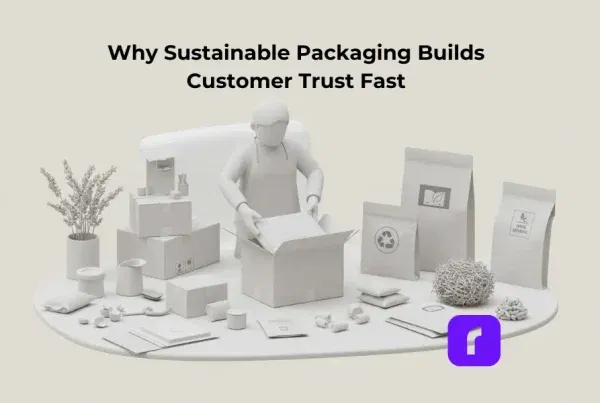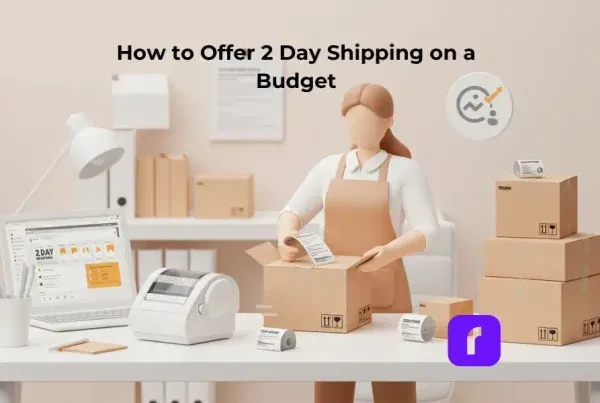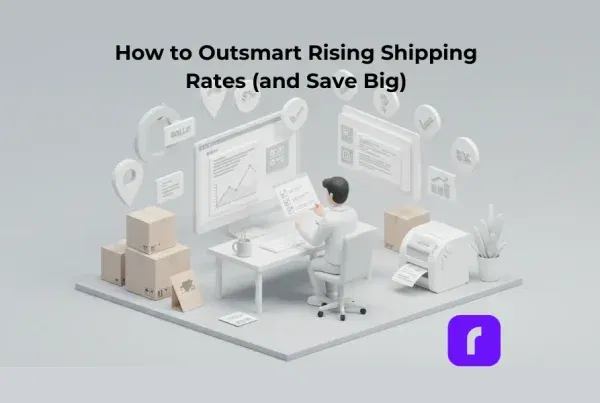Barcode printing is an unsung hero in e-commerce, streamlining the shipping process and enhancing efficiency. By reading this comprehensive guide, you can ensure your packages stay on track by following barcode printing standards.
Overall, your understanding of how to print barcodes for your shipping labels is important for your e-commerce business. So, let’s dive into everything you need to know about barcode printing, all tailored for your e-commerce success.
Table of Contents
Understanding the Basics of Barcodes
If you have bought a product since the 1970s, you have probably wondered what a barcode means.
First, a barcode is a scannable image on a product or package composed of inked lines and spaces. Each barcode encodes data in a visual pattern that machines can interpret. This data usually represents something specific about the product, like its type, size, or manufacturer.
In the realm of e-commerce and shipping, barcodes play a vital role. They streamline the tracking of inventory, help process orders, and ensure that every item reaches the right destination.
By scanning a barcode, businesses can access a wealth of information about the product. This can make processes like checkout, stock management, and shipping faster and more accurate. Barcodes, therefore, are essential tools in modern commerce. They bridge the gap between physical products and digital data for seamless operations.
Essentially, barcodes are more than just lines on a label; they are a language of efficiency in e-commerce. Understanding the various types can be the first step in your journey to understanding your own shipping labels.
Here are the types of barcodes you may encounter:
- UPC Barcodes: Universal and ideal for retail products. This barcode can encode 12 numerical digits and is fairly simple in structure.
Example of a simple UPC barcode. Credit to: jing.fm. Source: Pinterest
- QR Codes: A modern and versatile upgrade to the standard barcode which stores more information.
Example of a simple QR barcode. Credit to: blog.hubspot.com. Source: Pinterest
- Code 128: Widely used in shipping and packaging, these barcodes can encode letters and numbers.
Examples of Barcode Type Standards. Credit to: creativemarket.com. Source: Pinterest
Need more information? Check out our deep dive blog post about what makes up a barcode.
Each type has its place in e-commerce, and knowing which to use is key to streamline shipping.
Setting Up Your Barcode Printing Station
Creating a barcode printing station is simple. A compact, efficient Rollo printer is your cornerstone. Setting up involves plugging in your printer, loading labels, and a few clicks on your computer. A space-saving and powerful tool, Rollo printers make this setup effortless.
Utilities for Printing Barcodes
- Rollo Ship: User-friendly and tailored for Rollo printers and the majority of e-commerce platforms.
- Third-Party Software: Options like Barcode Generator for more basic needs.
- E-commerce Platforms: Many have built-in barcode printing features.
- A barcode label printer, ideally a wireless high-resolution one.
Each utility offers unique features, and your choice will depend on your specific needs.
HQ barcode and label printing
Choosing the Right Barcode Labels
Selecting the right adhesive label is crucial. Materials and sizes vary, each suited for different products. Rollo Printers can print rolls of 2″ x 1″ barcode thermal labels with no need for ink or toner refills ever.
Don’t worry about printing barcodes again with Rollo Ship
and our easy-to-use wireless thermal printers!
Printing Barcodes with Precision and Efficiency
Rollo printers are synonymous with precision. They produce clear, scannable barcodes, ensuring your packages move smoothly through the shipping process.
Barcodes for Different Shipping Platforms
- USPS: Often uses Intelligent Mail barcodes for efficient sorting and tracking.
- UPS: Prefers MaxiCode barcodes, designed for quick scanning.
- FedEx: Utilizes PDF417 barcodes, ideal for their tracking system.
Understanding these differences helps you tailor your barcode printing for each platform, enhancing efficiency.
Integrating Barcode Printing in Your Shipping Workflow
Barcodes streamline your workflow, from sorting to track. Adding Rollo printers to your process means embracing efficiency. These printers integrate smoothly, enhancing your workflow without disrupting existing systems.
Just look at our thermal printer effortlessly printing rolls of barcodes. Wouldn’t that be easy?
Effortless and seamless shipping label printing. No monthly subscriptions!
Print & Ship with
Create custom labels for free!
Integrate barcodes with your brand labels
Troubleshooting Common Barcode Printing Issues
Encountering issues with barcode printing is normal. However, you can easily fix common challenges like print quality and label alignment with simple adjustments. For more complex issues, Rollo’s customer support is ready to assist.
Here are some frequent problems you may encounter while printing shipping barcodes and how to remedy them:
Blurry Barcodes
Causes: Blurry barcodes often result from low print resolution or poor-quality labels.
Fixes: Ensure your printer’s resolution settings are appropriate for barcode printing. Using high-quality, smooth labels can also prevent this issue, as rough or uneven surfaces can lead to blurriness.
Faded Barcodes
Understanding the Issue: Faded barcodes typically occur due to low ink or toner levels in your printer. Printing too quickly can also cause fading.
Solution: Check and replace your ink or toner cartridges if they are running low. Adjust the printing speed settings on your printer to ensure optimal ink application.
Misaligned Barcodes
Identifying the Problem: This can happen when the barcode is not properly positioned on the label, making it difficult to scan.
Quick Fix: Adjust the label feed in your printer and check the alignment settings in your barcode printing software.
Incomplete Barcodes
What Causes It: Incomplete barcodes occur when part of the barcode is missing or doesn’t print. Label size settings or the printer’s feed mechanism can cause them.
Resolving the Issue: Verify that the label size in your printing software matches the actual label size. Also, inspect the printer for any feed issues or obstructions.
If you are experiencing barcode clarity issues while printing with your Rollo printer, kindly refer to this troubleshooting guide:
Step 1- Check File Quality: Ensure the original file is high quality. Use the provided sample label for testing.
Step 2 – Printer Settings: If no improvement, adjust your printer’s settings.
Step 3 – Print Sample Label: Print a 4 x 6 sample label from Rollo Ship to check printer health. This should be printed clearly.
Potential Issues:
Label Quality: Use high-quality labels for better prints. Rollo labels are recommended.
Margins and Size: Ensure the design uses the full label without extra borders to avoid shrinking and fading.
Darkness and Speed Settings:
- For Rollo X1040 Wireless
Access the Rollo Printer Portal. Connect to the same Wi-Fi as your printer, open the Rollo App, and navigate to Menu > Settings > Default Rollo Printer > Settings. In “Printing Defaults,” adjust darkness and speed settings for better quality. - Rollo X1038 USB Printers – Control Panel on your PC > Devices and Printers > Right-click on Rollo > Printer Preferences > Settings Tab > Adjust Speed and Density. On Mac > Access these settings directly from the print menu > Choose “Printer Default” for Darkness, Print Speed, Feature Sets
Smudged Barcodes
The Challenge: Smudging can make barcodes unreadable. Printing on labels unsuitable for the type of printer often causes this.
How to Fix: Ensure you’re using the correct label type for your printer. For example, inkjet printers require different labels than thermal printers to prevent smudging.
Barcode Contrast Problems
What It Means: Barcodes need sufficient contrast between the bars and the background to be scannable. Low contrast can make them hard to read.
Solution Path: Adjust the darkness settings on your printer. Also, make sure you’re using high-quality labels with a matte finish to enhance contrast.
Skewed Barcodes
Identifying the Issue: Barcodes are printed at an angle, which makes them hard to scan, resulting in skewing.
Corrective Action: Check the printer for any mechanical issues that might be causing skewing. Also, make sure to load the labels correctly and place the printer on a level surface.
Each of these issues can disrupt the efficiency of barcode use in e-commerce and shipping. Regularly maintaining your printing equipment and using the right materials helps avoid common barcode printing errors.
A lot of these problems we discussed won’t happen when you let Rollo handle your e-commerce logistics. Save time, money, and trips to the post office with Rollo Ship.
What About Printing QR Codes?
QR codes and barcodes are both tools for storing information in a format that machines can read. However, they differ significantly in design and capacity.
Traditional barcodes are one-dimensional, consisting of vertical lines that represent data by varying their widths and spacings. They typically store limited information, such as a product number or price. Unlike QR codes, scanners read them in a single direction.
QR codes, on the other hand, can hold much more data. They can hold URLs, text, or even geographic coordinates. QR codes are a square made up of black and white pixels and smartphones can scan them from any direction.
This larger storage capacity makes QR codes ideal for a wider range of applications. from marketing and product labeling to digital ticketing and contactless payments.
As barcodes evolve, so do Rollo printers. From traditional barcodes to advanced QR codes, Rollo equips our printers to handle it all. We keep your business ahead of the curve in the fast-paced e-commerce world.
Summary
Barcode printing is a cornerstone of efficient e-commerce shipping. With Rollo’s innovative solutions, it becomes a strategic advantage, streamlining your operations and propelling your business forward. Embrace the future of e-commerce with Rollo – where efficiency and innovation meet.
Follow Rollo on:
📌 Q: Can I print shipping barcodes using a standard office printer?
💭 A: Yes, but we don’t recommend it. Office printers take a lot of ink and toner, and if you are shipping at any scale, that can get expensive. Plus the ink can smudge and make your package harder to deliver. Try a thermal printer instead, like the ones that Rollo sells.
📌 Q: Do I need special software to generate barcodes for my products?
💭 A: Yes, barcode generation requires software or online tools to create scannable barcodes.
📌 Q: Are there different types of barcodes?
💭 A: Yes, there are various barcode formats, like UPC or QR codes, each suited for different products and uses.


